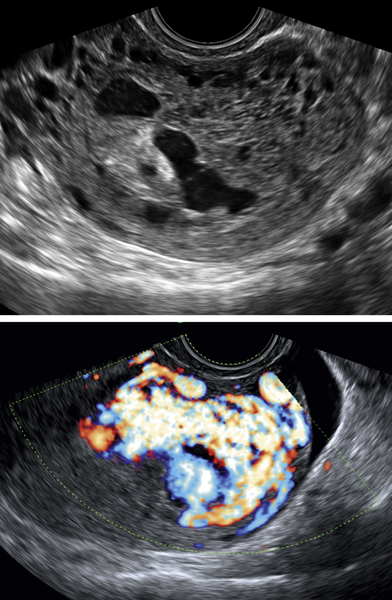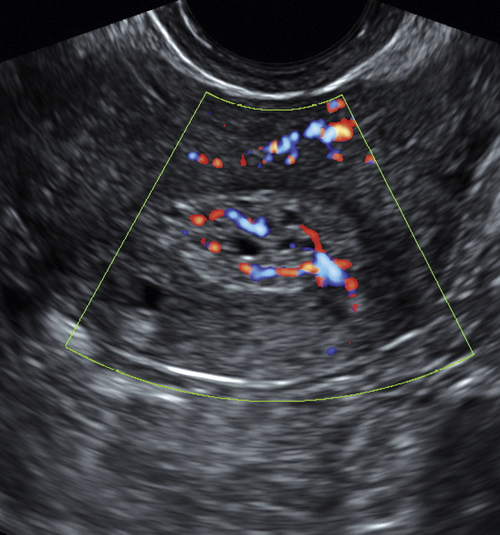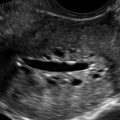Retained Products of Conception
Synonyms/Description
Etiology
Ultrasound Findings
Differential Diagnosis
Clinical Aspects and Recommendations
Figures

Figure R1-1 Typical case of RPOC after an incomplete first trimester pregnancy loss. A and B (gray-scale views) show the ill-defined margins of the endometrium at the fundus with irregular cystic spaces. The color Doppler in C shows that these spaces are blood vessels in this very vascular case of RPOC.

Figure R1-2 A to D, The uterine cavity contains an echogenic mass, filling the cavity (A) and extending to the edge of the endometrium, blurring the margins (B, calipers). C shows the abundant color flow at the site of the RPOC. D shows the 3-D appearance of the same case, demonstrating an asymmetric enlargement and deformity of the left fundus/cornu, representing the RPOC.

Figure R1-3 A to C, Sclerotic RPOC, 6 months after a term delivery (2-D, Doppler, and 3-D images). Note the complex-appearing vascular mass involving the endometrium. If this were seen in a postmenopausal patient with bleeding, the appearance would be consistent with endometrial cancer. The history of a symptomatic postpartum patient enabled the correct diagnosis of longstanding RPOC (sclerotic on pathologic examination).

Figure R1-5 Rare case of spontaneous AVM unrelated to pregnancy. The entire uterus is replaced by cystic areas on gray-scale imaging. Color flow Doppler shows abnormal vessels reaching to the serosa and involving much of the myometrium. The pattern and clinical history were very different in this nulliparous patient.
Suggested Reading
Atri M., Rao A., Boylan C., Rasty G., Gerber D. Best predictors of grayscale ultrasound combined with color Doppler in the diagnosis of retained products of conception. J Clin Ultrasound. 2011;39:122–127.
Casikar I., Lu C., Oates J., Bignardi T., Alhamdan D., Condous G. The use of power Doppler colour scoring to predict successful expectant management in women with an incomplete miscarriage. Hum Reprod. 2011;27:669–675.
Creinin M.D., Huang X., Gilles J., Barnhart K., Westhoff C., Zhang J. Medical management of early pregnancy failure. Obstet Gynecol. 2006;107:901–907.
Durfee S.M., Frates M.C., Luong A., Benson C.B. The sonographic and color Doppler features of retained products of conception. J Ultrasound Med. 2005;24:1181–1186.








